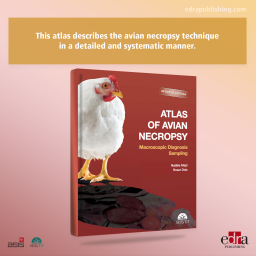This atlas describes the avian necropsy technique in a detailed and systematic manner. It also provides information about the pathologies commonly observed in poultry at the slaughterhouse, as well as guidelines on how to collect samples for diagnostic tests. This updated edition includes, in addition to more than 200 images, explanatory videos to obtain the maximum diagnostic yield.
The necropsy and subsequent evaluation of gross lesions is a gold standard diagnostic tool in the veterinary profession. This procedure is also commonly performed by veterinary practitioners during routine visits to poultry farms. However, little information exists on how to perform a necropsy on a bird to maximize the diagnostic yield of this procedure. The main aim of this book is to serve as a guide both to poultry vets and veterinary students, with information about the necropsy technique, the evaluation of gross lesions and the collection of samples for further testing. We hope that the videos and numerous images it includes will greatly facilitate understanding and application of its content. The first part of the book details the avian necropsy technique, how each organ and system should be inspected, and what they look like when there are no lesions. Some of the most relevant gross lesions – and in some cases, microscopic lesions – in avian pathology are then presented, grouped by organ or system. Finally, guidelines are provided on how to collect necropsy samples for further testing. We sincerely hope this book will be useful to all professionals in the poultry sector.
Authors
Natàlia Majó Masferrer
Holds a PhD in veterinary medicine from the University of Barcelona (UAB) and is a Diplomate of the European College of Veterinary Pathologists (ECVP) and of the European College of Poultry Veterinary Science (ECVPS). She is currently professor in the Department of Animal Health and Anatomy at the Faculty of Veterinary Medicine of the UAB and a researcher at the Centre for Research into Animal Health (CReSA). Her teaching and research focus on animal pathology, more specifically avian pathology. She is head of the Veterinary Pathology Diagnostic Service at the Faculty of Veterinary Medicine of the UAB. Her latest research projects have dealt with avian viral diseases: avian infectious bronchitis, Gumboro disease and avian influenza. She has published more than 80 articles in international journals and participated in many seminars and congresses in Spain and elsewhere. She has supervised 10 PhD theses on topics related to veterinary pathology. She has also taught training courses in avian pathology. She is a member of the ECVP Council and of the Board of Directors of the Spanish Association of Poultry Science (AECA).
Roser Dolz Pascual
Roser Dolz Pascual holds a PhD in veterinary medicine from the University of Barcelona (UAB) and is a Diplomate of the European College of Poultry Veterinary Science (ECVPS). She was a researcher at the Centre for Research into Animal Health (CReSA) for 7 years after completing her PhD, and collaborated in the Veterinary Pathology Diagnostic Service at the UAB. Her research focused on viral diseases and on Campylobacter, with research projects at a national and European level. In 2014, she became a manager at PH Ibérica, dedicated to developing and selling feed additives. After two years, she joined the MSD Animal Health team, where she currently works as a technical specialist in poultry. She has published more than 20 articles in international scientific journals and has participated as a speaker at numerous poultry seminars, courses and congresses on poultry, both in Spain and elsewhere.
Table of Contents
1. Necropsy technique in poultry
Previous aspects to keep in mind
Characteristics and stages of the necropsy technique
External examination and sampling of the bird in vivo
Preparation of the cadaver and opening the coelomic cavity
Extraction of the internal organs
Study and evaluation of the internal organs
Study of the head: evaluation of the nasal cavity and brain
Study of the musculoskeletal system: evaluation of the nerves, joints, bones and muscles
2. Macroscopic evaluation of the organs
Previous aspects to keep in mind
Skin and subcutaneous tissue
Respiratory system
Digestive system
Cardiovascular system
Lymphohematopoietic system
Genitourinary system
Musculoskeletal system
Nervous system
3. Sampling and other general considerations
Practical aspects to keep in mind
Histopathology
Microbiology/bacteriology
Virology
Molecular biology
Serology
Parasitology
Toxicology













